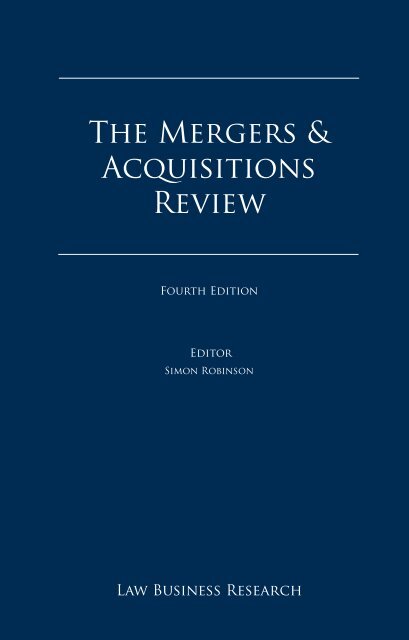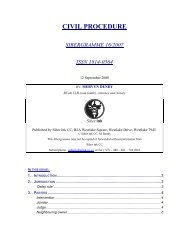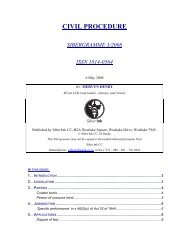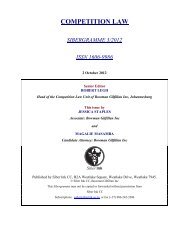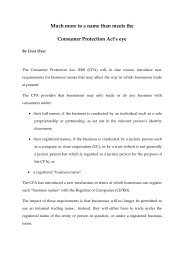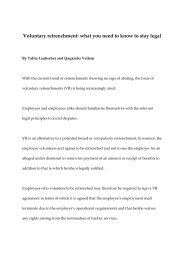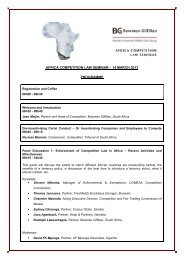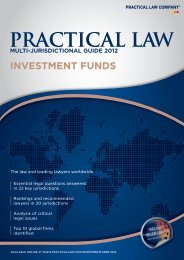A The Mergers - Bowman Gilfillan Attorneys
A The Mergers - Bowman Gilfillan Attorneys
A The Mergers - Bowman Gilfillan Attorneys
You also want an ePaper? Increase the reach of your titles
YUMPU automatically turns print PDFs into web optimized ePapers that Google loves.
<strong>The</strong> <strong>Mergers</strong> & Acquisitions Review<strong>The</strong> <strong>Mergers</strong> &fourth editionAcquisitionsReviewReproduced with permission from Law Business Research Ltd.This article was first published in <strong>The</strong> <strong>Mergers</strong> & Acquisitions Review, 4th Edition(published in September 2010 – editor Simon Robinson).For further information please emailAdam.Sargent@lbresearch.comFourth EditionEditorSimon RobinsonLaw Business Research
<strong>The</strong> <strong>Mergers</strong> & Acquisitions Reviewfourth editionReproduced with permission from Law Business Research Ltd.This article was first published in <strong>The</strong> <strong>Mergers</strong> & Acquisitions Review, 4th Edition(published in September 2010 – editor Simon Robinson).For further information please emailAdam.Sargent@lbresearch.com
Contents<strong>The</strong> <strong>Mergers</strong> &AcquisitionsReviewFourth EditionEditorSimon RobinsonLaw Business Research Ltd
ContentsPublisherGideon Robertonbusiness development managerAdam Sargentmarketing assistantHannah Thwaiteseditorial assistantNina Nowakproduction managerAdam Myersproduction editorJoanne MorleysubeditorCharlotte Stretcheditor-in-chiefCallum Campbellmanaging directorRichard DaveyPublished in the United Kingdomby Law Business Research Ltd, London87 Lancaster Road, London, W11 1QQ, UK© 2010 Law Business Research Ltd© Copyright in individual chapters vests with the contributorsNo photocopying: copyright licences do not apply.<strong>The</strong> information provided in this publication is general and may not apply in a specificsituation. Legal advice should always be sought before taking any legal action basedon the information provided. <strong>The</strong> publishers accept no responsibility for any acts oromissions contained herein. Although the information provided is accurate as ofJuly 2010, be advised that this is a developing area.Enquiries concerning reproduction should be sent to Law Business Research, at theaddress above. Enquiries concerning editorial content should be directedto the Publisher – gideon.roberton@lbresearch.comISBN 978-1-907606-03-8Printed in Great Britain byEncompass Print Solutions, DerbyshireTel: +44 870 897 3239
acknowledgements<strong>The</strong> publisher acknowledges and thanks the following law firms for their learnedassistance throughout the preparation of this book:Firm namesAdvokatfirmaet Hjort DAǼLEXAllens Arthur RobinsonAmarchand & Mangaldas & Suresh A Shroff & CoAnderson Mōri & TomotsuneArias & MuñozArias, Fábrega & FábregaBatliner Wanger Batliner <strong>Attorneys</strong> at Law LtdBernotas & Dominas Glimstedt<strong>Bowman</strong> <strong>Gilfillan</strong>Bredin PratBrigard & Urrutia AbogadosCamilleri PreziosiCharles Adams Ritchie & DuckworthCoulson HarneyCravath, Swaine & Moore LLPDittmar & IndreniusDryllerakis & AssociatesELIG <strong>Attorneys</strong> at LawEubeliusF Castelo Branco & AssociadosFontes & Tarso Ribeiro Advogados
AcknowledgementsGlatzová & Co., v.o.s.Glimstedt & PartnersGlimstedt Straus & PartnersGorrissen FederspielHengeler MuellerKhan & AssociatesKim & ChangLawCastlesMakes & Partners Law FirmMannheimer Swartling AdvokatbyråMarval, O’Farrell & MairalMatheson Ormsby PrenticeMiro Senica and attorneys, d.o.o.Mondini Rusconi Studio LegaleMoravčević Vojnović Zdravković OAD in cooperation withSchönherrMoreno Baldivieso Estudio de AbogadosNagy és Trócsányi Ügyvédi IrodaNautaDutilhNoble & ScheideckerOsler, Hoskin & Harcourt LLPPayet, Rey, Cauvi AbogadosPenkov, Markov & PartnersQuevedo & PonceRužička Csekes s.r.o.S Horowitz & CoSantamarina y Steta, SCii
AcknowledgementsSchellenberg WittmerSchönherr Rechtsanwälte GmbHSlaughter and MayStamford Law CorporationSullivan & Cromwell LLPTorres, Plaz & AraujoUría MenéndezVasil Kisil and PartnersWinkler PartnersYoung Conaway Stargatt & Taylor, LLPiii
ContentscontentsEditor’s Preface...............................................................................................................xiSimon RobinsonChapter 1 EU Competition Overview ................................................1Juan RodriguezChapter 2 European Overview ..............................................................7Simon RobinsonChapter 3 US Competition Overview .............................................. 24Antitrust Group of Sullivan & Cromwell LLPChapter 4 Argentina .................................................................................. 39Alejandro D Fiuza and Pablo GayolChapter 5 Australia ..................................................................................... 48Ewen Crouch and Eve RegnardChapter 6 Austria .......................................................................................... 62Christian HerbstChapter 7 Belgium ........................................................................................ 71Koen Geens and Marieke WyckaertChapter 8 Bolivia ........................................................................................... 78Luis F Moreno GChapter 9 Brazil ............................................................................................. 86Marcus Fontes, Max Fontes and Paulo de Tarso RibeiroChapter 10 Bulgaria ...................................................................................... 96Roman Stoyanov and Svetoslav DimitrovChapter 11 Canada ........................................................................................ 105Robert Yalden, Ward Sellers and Emmanuel PressmanChapter 12 Cayman Islands .................................................................... 117Antony Duckworth and Alan de Saramiv
ContentsChapter 13 Colombia ................................................................................... 121Sergio Michelsen JaramilloChapter 14 Costa Rica ................................................................................. 133Vicente Lines and Carmen de Maria CastroChapter 15 Czech Republic ..................................................................... 140Vladimíra Glatzová and Markéta BudkovskáChapter 16 Denmark .................................................................................... 150Henrik Thouber and Anders Ørjan JensenChapter 17 Ecuador ..................................................................................... 159Alejandro Ponce MartínezChapter 18 Estonia ....................................................................................... 164Ilmar StrausChapter 19 Finland ....................................................................................... 173Jan Ollila, Anders Carlberg and Wilhelm EklundChapter 20 France ......................................................................................... 182Didier MartinChapter 21 Germany .................................................................................... 198Christian Möller and Heinrich KnepperChapter 22 Greece ......................................................................................... 209Cleomenis G Yannikas, Vassilis-Thomas G Karantouniasand Sophia K GrigoriadouChapter 23 Hong Kong .............................................................................. 218George Goulding and Jason WebberChapter 24 Hungary ..................................................................................... 228Péter Berethalmi and Tamás PásztorChapter 25 India .............................................................................................. 236Cyril ShroffChapter 26 Indonesia ................................................................................. 247Yozua MakesChapter 27 Ireland ....................................................................................... 257Patrick Spicer
ContentsChapter 28 Israel ............................................................................................ 267Clifford Davis and Keith ShawChapter 29 Italy .............................................................................................. 277Giovanni Stucchi and Luca TiberiChapter 30 Japan .............................................................................................. 290Hiroki Kodate and Risa FukudaChapter 31 Kenya ........................................................................................... 301Richard HarneyChapter 32 Korea ........................................................................................... 307Sang-Hyuk Park and Gene-Oh KimChapter 33 Latvia ........................................................................................... 318Maris ButansChapter 34 Liechtenstein ....................................................................... 325Martin Batliner and Brigitte VogtChapter 35 Lithuania .................................................................................. 334Audrius ŽvybasChapter 36 Luxembourg ........................................................................... 341Marie-Béatrice NobleChapter 37 Malta ............................................................................................ 353Louis de Gabriele and Andrei VellaChapter 38 Mexico ......................................................................................... 360Jorge León-Orantes B and José Ramón Ayala AChapter 39 Montenegro .......................................................................... 371Milan Dakić and Slaven MoravčevićChapter 40 Netherlands ......................................................................... 380Willem CalkoenChapter 41 Nigeria ........................................................................................ 402L Fubara AngaChapter 42 Norway ........................................................................................ 407Elin Rostveitvi
ContentsChapter 43 Pakistan ..................................................................................... 420Mansoor Hassan KhanChapter 44 Panama ........................................................................................ 429Eduardo de Alba and Julianne CanavaggioChapter 45 Peru ............................................................................................... 436José Antonio Payet, Carlos A Patrón and Susan CastilloChapter 46 Portugal ................................................................................... 447Rodrigo Almeida DiasChapter 47 Serbia ........................................................................................... 456Petar Kojdić and Matija VojnovićChapter 48 Singapore ................................................................................. 462Lee Suet-Fern and Elizabeth Kong Sau-WaiChapter 49 Slovakia ..................................................................................... 474Jana PagáčováChapter 50 Slovenia ..................................................................................... 486Melita Trop and Uroš PodobnikChapter 51 South Africa .......................................................................... 496Ezra Davids and Ashleigh HaleChapter 52 Spain .............................................................................................. 505Christian Hoedl and Javier Ruiz-CámaraChapter 53 Sweden ........................................................................................ 515Biörn Riese, Eva Hägg and Cecilia BjörkwallChapter 54 Switzerland ........................................................................... 524Lorenzo Olgiati, Martin Weber and Jean Jacques Ah ChoonChapter 55 Taiwan ......................................................................................... 538Steven J HanleyChapter 56 Tanzania ................................................................................... 548Ngassa DindiChapter 57 Turkey ......................................................................................... 560Tunç Lokmanhekim and Berna Aşık Zibelvii
ContentsChapter 58 Ukraine ...................................................................................... 567Denis Lysenko and Anna BabychChapter 59 United Kingdom ................................................................. 579Simon RobinsonChapter 60 United States ........................................................................ 599Richard Hall and Mark GreeneChapter 61 United States: Delaware .................................................... 616Rolin P Bissell and Elena C NormanChapter 62 Venezuela ............................................................................... 629Guillermo de la Rosa, Juan D Alfonzo, Pedro Uriola,Nelson Borjas and Ana C GonzálezAppendix 1 About the Authors ........................................................... 641Appendix 2 Contributing law firms’ contact details .... 679viii
editor’s prefaceIn response to the financial crisis, the past year has been spent cutting costs and restoringbalance sheets while governments have set about overhauling the regulatory landscape.Whether as a result of this approach or in spite of it, we have seen the first signs ofa recovery in the second half of 2009. During the financial meltdown, many strongbusinesses focused on assessing their strategy and restructuring. As the signs of recoverybegan to emerge, such businesses tentatively started to re-engage in M&A transactionsas a means of achieving growth.Currently, buyers are conscious of scrutiny from shareholders with regards to howmuch is being paid for assets and whether the deals that are going ahead represent valuefor money (particularly in light of Warren Buffett’s publicly voiced concerns during thecourse of Kraft’s bid for Cadbury and shareholder reaction to the proposed acquisitionof part of AIG by Prudential). Consequently, most potential buyers are treading carefully.On the other hand, there were also a number of quick deals in 2009 where a speedyresolution was necessary to allow distressed sellers to obtain cash promptly but thenumber of these should decrease throughout 2010 if we continue through to recovery.Many are still cautious about the outlook for M&A activity for the remainderof 2010 and beyond. A rise in M&A activity is hugely dependent on the willingness ofbanks to increase lending. Access to credit plays a vital role in supporting the economyby helping businesses to create jobs and growth, both of which are necessary if weare to find our way out of recession and towards recovery. In the short term, M&Aactivity will depend heavily on boardroom confidence and such confidence will onlybe achieved if boards perceive that the few new M&A deals around have provenprofitable for shareholders. Such confidence and optimism is slow to build; therefore,xi
Editor’s Prefacewhile pockets of activity suggest that the worst of the financial crisis is behind us, thesigns of recovery are tentative with buyers urging caution. <strong>The</strong> journey to recovery willbe slow and difficult, but as lending increases and confidence rises, economists expectthe sluggish growth of 2010 to develop into greater stability into 2011. That said, therecent problems of the euro, European government finances and the European bankingsector could yet bring a renewed lapse into recession or worse. Only time will tell whichprogression turns out to be correct.I wish again to thank all the contributors for their continued support in producingthis book – one would hope that in this uncertain time the following chapters should atleast provide some food for thought.Simon RobinsonSlaughter and MayLondonJuly 2010xii
Chapter 51South AfricaEzra Davids and Ashleigh Hale *<strong>Bowman</strong> <strong>Gilfillan</strong>IOVERVIEW OF RECENT M&A ACTIVITYSouth Africa continued to feel the effects of a sluggish global economy, albeit on a morelimited basis compared to the rest of the world. This was reflected in a spike (albeitfrom a low base) in M&A activity in South Africa in the early part of 2010. <strong>The</strong> firstquarter of 2010 was particularly active and total M&A deal value was up about 110 percent compared to the first quarter of 2009. <strong>The</strong> upturn was more pronounced in crossborderdeals in South Africa and general corporate restructurings. <strong>The</strong>re were relativelyfewer black economic empowerment (‘BEE’) deals, which for a number of years haveprovided great impetus to the South African M&A market.Ironically, increased infrastructure spend, for the 2010 FIFA World Cup andbeyond, had no meaningful impact on M&A activity in the relevant sectors.Mainly due to the higher cost of debt, the private equity market in South Africais still slow in both the number and value of deals.It will be interesting to see how the rest of 2010 pans out, but all signs point toincreased activity in the M&A market.IIGENERAL INTRODUCTION TO THE LEGISLATIVE M&AFRAMEWORK<strong>The</strong> cornerstone of the South African M&A legislative framework is the Companies Act1973 (‘the Companies Act’). A new Companies Act 2008 (‘the New Companies Act’)was, however, promulgated in 2008 and is set to take effect in late 2010 or early 2011.This will significantly overhaul the existing company law regime and the M&A legislativeframework.* Ezra Davids and Ashleigh Hale are partners at <strong>Bowman</strong> <strong>Gilfillan</strong>.496
South AfricaAmong other things, the Companies Act regulates schemes of arrangement (astatutory procedure, which is the most commonly used method of implementing arecommended takeover), tender offers and a ‘squeeze-out’ mechanism when a bidderacquires 90 per cent of the shares in the target company. <strong>The</strong> Companies Act alsoregulates a disposal by the target of a greater part or all of its assets or business.South African mergers and acquisitions are also governed by the SecuritiesRegulation Code on Takeovers and <strong>Mergers</strong> (‘the Code’) (which is largely based on theUK City Code on Takeovers and <strong>Mergers</strong>) and the Rules of the Securities RegulationPanel (‘the Panel’). Unlike the UK City Code, the Code is statutory and is enforced by thecourts rather than through self-regulation. <strong>The</strong> Code applies to both public transactionsand private transactions of a certain value, and seeks to regulate those transactions thatare deemed to be ‘affected transactions’ (which includes those that involve a disposal ofthe whole or substantially the whole of the business of the company or that result in aperson acquiring 35 per cent or more of the voting rights in a company).Other key pieces of legislation include the Securities Services Act (which, amongother things, regulates the South African insider-trading and market manipulationlegislation) and the Competition Act. In M&A transactions involving companies listedon South Africa’s securities exchange the JSE Limited, the JSE Listing Requirements areof relevance.For many years, South Africa has had a system of exchange controls in placeaimed at regulating the flow of capital in and out of the country. <strong>The</strong>se controls (whichare set out in the Exchange Control Regulations 1961) have often played a significantrole in the manner in which M&A transactions in South Africa, particularly cross-bordertransactions, are structured. Recently, these exchange controls have been graduallyrelaxed, with the intention that they will ultimately be abolished. Examples of changesthat have been made to the system include the reduction of size of the minimum equitystake that South African corporates are required to hold in their foreign investments, andallowances being made for foreign companies to use their non-South African shares asacquisition capital for M&A transactions by means of a secondary listing on the JSE.Over and above the statutory framework outlined above, the South African lawof contract also obviously plays a significant role in regulating M&A transactions. Thisis derived primarily from South African common law, which is not codified.IIIDEVELOPMENTS IN CORPORATE AND TAKEOVER LAWAND THEIR IMPACTA new Companies Act has been promulgated, which will significantly overhaul the SouthAfrican company law regime. <strong>The</strong> new Companies Act is expected to take effect in thefourth quarter of 2010 or the first quarter of 2011.Key changes in the M&A sphere include:a provision for a new statutory merger procedure allowing for the merger of oneentity into another or the amalgamation of two entities into a new separate entity(currently there is no provision in South African law for mergers in the true senseof the word, and mergers and acquisitions in South Africa are generally effected497
South Africabcdefthrough the acquisition by one company of the shares in or business of anothercompany);the introduction of a shareholder appraisal rights regime for dissenting minorityshareholders in the context of schemes of arrangement, mergers, a disposal ofsubstantially all of the assets or business of undertaking or material changes tothe constitutive documents;the limitation of the role of the court in schemes;the introduction of a new regulator for M&A to replace the Securities RegulationPanel with the Takeover Regulation Panel;a new regime for affected transactions; andthe introduction of a new business rescue procedure.IVFOREIGN INVOLVEMENT IN M&A TRANSACTIONSAfter relatively slow cross-border M&A activity in 2009, signs are pointing to a relativeupturn, symbolised by the recently announced takeover bid by Japan’s NTT Corporationfor one of South Africa’s leading IT companies, Dimension Data.<strong>The</strong>re are also numerous investments by mainly Chinese, Indian and Koreancompanies in South Africa, often focused on the resources sector.South African companies are investing more and more in Africa in addition to thetraditional investment hubs.VSIGNIFICANT TRANSACTIONS, KEY TRENDS AND HOTINDUSTRIESiBlack economic empowerment transactionsOne of the main drivers of local M&A activity in recent years has been a type oftransaction that is unique to the South African environment, namely BEE transactions.Over the past 10 years or so, the South African government has put in placea regulatory framework aimed at ensuring the economic empowerment of previouslydisadvantaged black South Africans. It has become a key commercial imperative forcompanies aiming to do business in South Africa to ensure that they have sufficientempowerment credentials.From an M&A perspective one of the key elements of the government’s BEEpolicies has been the targets prescribed in respect of black equity ownership, and mostof the major companies in South Africa have concluded transactions in terms of whichthey have disposed of a significant equity stake (generally up to 25 per cent) to blackshareholders.Such transactions have created their own challenges, particularly as BEEinvestors often do not have access to sufficient funds to pay for the stake that theyare acquiring. Previously, the prohibition in South African company law on a companyproviding financial assistance for the purchase of its shares made vendor financing ofsuch transactions more difficult, but as discussed in greater detail below, this prohibitionhas recently been relaxed.498
South Africa<strong>The</strong> BEE equity ownership requirements have also proved challenging formultinational entities doing business in South Africa. In recognition of this, exceptionshave been made for multinationals in this regard in terms of which, in lieu of disposing ofan equity interest in their local operation, they can invest in equity equivalent programmesor dispose of a stake in the offshore parent company. Hewlett Packard, for example,has an established an HP Business Institute for the purpose of skills development inthe ICT sector as an equity equivalent programme. Other multinationals such as Ciscoand Merrill Lynch have concluded empowerment transactions whereby empowermentshareholders acquired shares in the ultimate listed offshore parent companies of thosecorporations.Most BEE transactions are dependent upon the dividend flow from the underlyingshares and the growth in value of the underlying shares. Due to the economic downturn,dividend proceeds and share growth have been low. This means that a number of BEEtransactions are now ‘under water’. This may result in a need for the refinancing orrestructuring of a number of BEE transactions.One of the more significant recent BEE transactions was the South AfricanBreweries broad-based empowerment transaction worth 7.7 billion rand. MTN has alsorecently announced its revised BEE deal with a value of 8 billion rand.ii Private equityPrior to the global ‘credit crunch’, South Africa experienced a significant increase inlarge private equity deals. Examples of large deals that have taken place include theacquisition by Bain Capital of Edcon Limited, a major South African retailer, for $4.5billion and the acquisition by Actis of Alexander Forbes, a major player in the SouthAfrican insurance and financial services industry. Mainly due to the higher cost of debt,the private equity market in South Africa is still slow in the number and value of deals.Recently, a bid by Brait and Management for Freeworld Coatings failed because it wasvoted down by shareholders.iii Corporate restructuringAnother key driver of M&A activity in South Africa has been corporate restructuringsin the form of demergers (unbundling) of non-core assets by major South Africancompanies. A recent example of this is the unbundling by the Mvela Group and BrimstoneInvestment Corporation Ltd to its ordinary shareholders of their interests held in LifeHealthcare upon the listing of Life Healthcare on the JSE on 10 June 2010.iv Inward investmentInward investment is likely to continue to play a significant role in the South AfricanM&A market going forward. A recent example is the takeover bid announced by Japan’sNTT Corporation for one of South Africa’s leading IT companies, Dimension Data.v Other significant transactionsIn the leisure sector, Gold Reef Resorts acquired Tsogo Sun Holdings for $2.7 billion.In the first half of 2010, the leisure sector made up the largest proportion of M&A inSouth Africa by deal value.499
South AfricaAnother large deal announced in the first quarter of 2010 was the merger ofthe Momentum Group and Metropolitan Life to create a major new South Africaninsurance group. <strong>The</strong> deal value is $2.4 billion.VIFINANCING OF M&A: MAIN SOURCES AND DEVELOPMENTS<strong>The</strong> South African acquisition finance market has continued seeing a movement awayfrom the borrower-friendly market that existed at the end of 2007 to a loan market thathas favoured lenders in 2010. In keeping with the European trend, borrowers have notbeen able to obtain lending terms comparable with those achievable a couple of yearsago. However the local leveraged acquisition market is sector-specific and, for example,borrowers in the resources and allied sector have continued to attract favourable termsfrom lenders. In other sectors, though, borrowers have struggled to obtain leveraged creditand lenders in this sector have experienced difficulties in syndicating their participationin leveraged deals. Many acquisitions, in particular private equity acquisitions, werefinanced using offshore ‘high-yield’ bonds in preference to bank debt financing. Thisavenue of financing has ceased to be used in the South African market and historicalhigh-yield debt financings have come under pressure.Due to market volatility certain deals have required modification in order to achievesuccessful hold positions and in some instances syndications have been postponed asthe prevailing market conditions have been deemed unfavourable. In addition marketflex terms and market disruption events have become much more prevalent in leveragedfinance transactions, something that was fairly uncommon two years ago. <strong>The</strong>re hasalso been an increase in debt covenant defaults or potential defaults. As a result,many transactions concluded over the past four years have had to be restructured orrefinanced.<strong>The</strong> number of private equity transactions, including public-to-private takeouts,has decreased substantially during the year.VIIEMPLOYMENT LAWFrom an employment law perspective, one of the key legislative provisions in the contextof M&A is Section 197 of the Labour Relations Act, which provides for the automatictransfer of employment contracts from seller to a purchaser where there is a sale of abusiness (or a portion thereof) as a going concern. <strong>The</strong> effect of this is that the newemployer is automatically substituted in the place of the old employer in respect of allthe relevant contracts of employment in existence immediately. <strong>The</strong> employees whoare transferred must be employed on terms that are ‘on the whole not less favourable’,the purchaser is bound by collective agreements that relate to conditions of serviceand by relevant arbitration awards and any conduct of the seller, such as discriminatorypractices, is deemed to be the conduct of the purchaser. <strong>The</strong>refore, proper due diligenceis key for the acquirer of any business and appropriate warranties and indemnities areadvised. In a recent case, it was held that the dismissal of an employee for a reasonrelated to a transfer was held to constitute an unfair dismissal, and the employer wasrequired to compensate the employee therefore.500
South AfricaPension funds are primarily regulated by the Pension Funds Act. Many SouthAfrican employers still subscribe to private retirement funds, whose membership isrestricted to employees of a particular company or group of companies, although multiemployer‘umbrella’ retirement funds are more common among smaller and newercompanies. In a merger or acquisition a new employer may only become a participatingemployer if the rules of the fund allow for the new employer’s participation, which maynecessitate rule amendments or transfer of business to the acquiring entity’s fund. Sucha transfer would need to be approved by the Registrar of Pension Funds, which wouldinvolve a delay of some months, although retrospective approval is usually permitted onapplication. <strong>The</strong>refore, proper due diligence of the existing fund is advisable, whether itremains the applicable vehicle or transfers its business to a new fund.Other employee benefits, such as medical insurance, share incentive schemes,housing and building loans, HIV/AIDS education and treatment programmes and postemploymentmedical subsidisation, among others, are generally dealt with in accordancewith the ordinary common law principles of contract or trust law, but in a number ofimportant respects they are subject to the provisions of the Labour Relations Act, theEmployment Equity Act, the Basic Conditions of Employment Act and the Constitution,especially in regard to anti-discrimination provisions. Due diligence in these respects isalways advised.VIII TAX LAWi Secondary tax on companies (‘STC’), withholding tax on dividends and value extraction taxSouth Africa has an unusual form of taxation known as STC. STC is a second level ofcorporate tax, which is currently levied at the rate of 10 per cent on the ‘net amount’distributed by a South African-resident company, as a dividend. As STC is borne by thecompany declaring the dividend rather than by the shareholder, STC is not a withholdingtax in the true sense of the word.It has been announced that STC will be replaced with a withholding tax ondividends in the near future. <strong>The</strong> rate of withholding will be 10 per cent of the amountof the dividend, although such rate could be reduced in terms of some of the doubletaxtreaties concluded by South Africa to 5 per cent in the case of a shareholding of atleast 10 per cent. Although some treaties provide for a zero per cent rate of withholding,the tax authorities have announced that the new dividend withholding tax will not beintroduced until such time as the tax treaties have been renegotiated to ensure that atleast a 5 per cent rate of withholding tax can be imposed on the dividend by SouthAfrica. <strong>The</strong>se negotiations are taking place. Furthermore, a new Value Extraction Tax(‘VET’) will also come into effect, probably in 2011. <strong>The</strong> VET forms part of the newregime which is set to replace STC. <strong>The</strong> VET will be payable by a company which is a SAresident at the rate of 10 per cent and must be paid by the end of the month followingthe month in which the value extraction took place. <strong>The</strong> VET essentially replaces thedeemed dividend anti-avoidance rules found in the STC legislation. Four types oftransactions will attract the VET, namely loans granted by a company to a connectedperson at an interest rate below a deemed market related interest rate, the waiver ofany loan obligation owing by a connected person to the company, the settlement by the501
South Africacompany of any debt owing by a connected party of the company to a third party andwhen the company ceases to be a South African tax resident.i Interest exemption for non residents – changesCurrently, interest received by or accruing to non-residents is exempt from South Africanincome tax, provided that the non-resident does not carry on business in South Africa atany time during the course of the tax year, through a permanent establishment. If a nonresident receives interest income that does not qualify for the income tax exemption, thetax payable does not take the form of a withholding tax and the recipient of the interestwill have to account for the tax.However, the tax exemption that currently applies to interest earned by nonresidentsis in the process of being amended. <strong>The</strong> proposed amendments will apply inrespect of any interest that accrues, is received, becomes payable or which is deemed tohave accrued on or after 1 March 2011. <strong>The</strong> general effect of the proposed amendmentwill be that all interest received by non-residents will now be taxed, although interest willbe exempt from South African income tax if the interest is earned in respect of certaindomestic investments such as government bonds, bonds listed on the JSE, collectiveinvestment schemes, bank deposits (this exemption for bank deposits does not includeback-to-back loan agreements designed to circumvent the general rule of taxationand the exemption will not apply if the bank acts as an intermediary to facilitate theborrowing of funds by a domestic company from a foreign lender), international tradefinance, dealer and brokerage accounts, and any interest received or accrued to a nonresidentfrom another non-resident.ii Thin capitalisation changes<strong>The</strong> South African tax legislation contains provisions that limit the tax deduction ofinterest paid on debt arrangements between certain related parties. <strong>The</strong> rules specificallyapply where a non-resident grants financial assistance to a related South African residentor any other South African resident company in which the non-resident has a director indirect interest entitling it to participate in at least 25 per cent of the dividends,profits or capital of the company or to exercise at least 25 per cent of the votes in theSouth African company. In order for the provisions to apply to a specific transaction,the South African Revenue Service must be of the opinion that, having regard to thecircumstances, the total value of the financial assistance is excessive in relation to thefixed capital of the recipient of the financial assistance.<strong>The</strong>se thin capitalisation rules in are in the process of being amended and theamendments are intended to come into operation when the New Companies Act takeseffect in late 2010 or early 2011. <strong>The</strong> amended rules will apply to financial assistancegranted by non-residents to South African residents, and to financial assistance grantedby non-residents to other non-residents that have permanent establishments in SouthAfrica. <strong>The</strong> effect of the amendments is that the South African branches of foreigncompanies will be treated in the same manner as the subsidiaries of foreign companies.502
South AfricaIXCOMPETITION LAWAs the thresholds for mandatory merger notification were raised during 2009, fewermergers are required to be notified to the competition authorities, allowing theCompetition Commission (‘the Commission’) to focus on those mergers having asubstantial effect on competition. During 2009/10, the Commission considered 208merger notifications (compared to 450 mergers finalised in the previous year). <strong>The</strong> 208notifications related to 14 small mergers (11 were approved unconditionally, none wereprohibited and two were withdrawn); 140 intermediate mergers (131 of these wereapproved unconditionally, five were approved conditionally, none were prohibited andfour were withdrawn); and 54 large mergers (48 of these were approved unconditionallyand two conditionally, one was prohibited and three were withdrawn).It is not mandatory to notify small mergers unless the Commission requiresnotification of a small merger. However, a guideline was issued by the Commission in2009, in which the Commission requires the notification of small mergers if, at the timeof entering into the merger, any of the firms, or firms within their group, are subjectto an investigation by the Commission in terms of Chapter 2 of the Competition Act(which deals with prohibited vertical and horizontal practices, as well as the abuse ofdominance) or if, at the time of entering into the merger, any of the firms, or firmswithin their group, are respondents to pending proceedings referred by the Commissionto the Competition Tribunal in terms of Chapter 2 of the Competition Act.<strong>The</strong> majority of mergers are approved but the authorities will use their powersin relation to domestic and foreign-to-foreign mergers where they consider competitionconcerns are raised. <strong>The</strong>y may prohibit mergers or approve them conditionally orunconditionally. <strong>Mergers</strong> in the sectors identified by the Commission as priority sectorsattract closer scrutiny. <strong>The</strong> Commission’s priority sectors are food and agro-processing,construction and infrastructure, intermediate industrial products and financial services.<strong>The</strong>se are regarded as sectors that have an impact on consumers: an impact on thecost of doing business and an impact on economic growth and development or reflectcompetition concerns (such as featuring cartel conduct).In 2009, the M&A Division of the Commission revised its service standards,publishing review periods that the Commission will commit to achieving for phase 1(non-complex), phase 2 (complex) and phase 3 (very complex) mergers. <strong>The</strong>se reviewperiods do not replace the review periods set out in the Competition Act, but theCommission seeks to adhere to these periods, particularly in the interests of expeditingthe review of non-complex mergers. <strong>The</strong> Commission commits to reviewing phase 1mergers within 20 business days; phase 2 mergers within 45 business days and phase 3mergers within 60 business days.<strong>The</strong> amendments to the Competition Act are also worth noting. <strong>The</strong> CompetitionAmendment Act has been passed into law but is only expected to take effect in thesecond half of 2010. Perhaps the most significant amendment is that which provides foran investigation by the Commission where merging parties have implemented a mergerwithout competition clearance. In terms of the Competition Act, failure to notify theCommission of a notifiable merger or the implementation of a notifiable merger priorto approval being obtained is a contravention, rendering the parties liable to pay anadministrative penalty of up to 10 per cent of turnover in South Africa and exports from503
South AfricaSouth Africa. An investigation into whether parties did implement a merger withoutnecessary clearance may be initiated by the Commission or pursuant to a complaintlodged by a third party.XOUTLOOKAlthough the global and domestic economic slowdown has undoubtedly had an effecton the South African M&A market, the key drivers that fuelled M&A activity duringthe past few years (such as BEE transactions, corporate restructurings, resource-relatedtransactions and general foreign direct investment from India and China in particular)have ensured a steady stream of M&A activity in 2009 and 2010 and are likely to continueto play a significant role in coming years. Other key factors that are likely to play a rolegoing forward include the imminent overhaul of the South African company legislationand the continued relaxation of exchange controls. <strong>The</strong>re is also an expectation that thesuccessful hosting of the 2010 FIFA World Cup will result in increased interest in SouthAfrica by multinationals.<strong>The</strong> South African economy does, however, continue to face significant challenges(such as infrastructure development, high unemployment and a burgeoning currentaccount deficit) that may have an impact going forward on the growth of the economyand M&A activity. Other areas of concern include a critical shortage of key skills, thehigh prevalence of HIV/AIDS, the exorbitant cost of telecommunications and chronicpoverty. All of these will need to be addressed if the South African economy is to continueon an upward trajectory and to continue to attract significant foreign investment.504
Ezra Davids<strong>Bowman</strong> <strong>Gilfillan</strong>About the AuthorsEzra Davids is a partner in and the head of <strong>Bowman</strong> <strong>Gilfillan</strong>’s corporate department.He specialises in mergers and acquisitions (M&A, capital markets and securities law). MrDavids has led the <strong>Bowman</strong> <strong>Gilfillan</strong> team in some of the largest M&A deals in the pastyear, including the disposal by Barrick Gold Corporation of Barrick Gold South Africato Gold Fields Limited ($1.55 billion), the acquisition by MTN Group of Investcom($5 billion) and the disposal by Polyus of its entire shareholding in Gold Fields Limited($2.02 billion). In capital markets he headed the teams in advising Goldman Sachs andUBS as joint global coordinators in the combined offering by Anglo American plc andAngloGold Ashanti of AngloGold Ashanti shares ($1.69 billion) and Witsgold on itsIPO on the JSE Limited.Mr Davids is also the relationship partner for some of the firm’s clients likeGoldman Sachs, UBS, Deutsche Bank, Merrill Lynch, Kohlberg Kravis Roberts, Eskom,Transnet, Barrick Gold Corporation, Public Investment Corporation, UPS and MerafeResources.Who’s Who Legal (2010) has named Mr Davids as one of the leading M&Alawyers in South Africa. He is past chairman of the Recent Developments in M&Aof the International Bar Association and is a contributor to a number of internationalpublications. Mr Davids is also a member of the faculty advisory board of the LawFaculty of the University of Cape Town.Ashleigh Hale<strong>Bowman</strong> <strong>Gilfillan</strong>Ashleigh Hale is a partner in <strong>Bowman</strong> <strong>Gilfillan</strong>’s corporate department. Her practicefocuses on mergers and acquisitions and the privatisation and restructuring of state assets.She also has a broad range of general commercial law experience, for example, relatingto joint ventures, IT outsourcing and tender submissions and contract negotiations.Ms Hale has advised a range of multinational and local companies, including,Sumitomo, Sojitz, Nippon Steel, Bureau Veritas, Alcatel-Lucent, Gemalto, Turbomeca,Marsh South Africa, Ericsson South Africa and Amdocs. Ashleigh has also advised in anumber of black economic empowerment (‘BEE’) equity transactions (acting for bothBEE consortia and the companies in which they purchase equity).In relation to the privatisation and restructuring of state assets, Ms Hale waspart of the team which advised Transnet in relation to its proposed restructuring ofSpoornet during 2000, and was co-lead attorney representing Turbomeca in relation toits acquisition of the Airmotive Division of Denel. Ms Hale has also advised Transnetand Eskom in relation to the disposal of certain of certain non-core assets and theBotswana Telecommunications Corporation in relation to its proposed privatisation.
<strong>Bowman</strong> <strong>Gilfillan</strong>165 West StreetSandton, 2146South AfricaTel: +27 11 669 9000Fax: +27 11 669 9001info@bowman.co.zawww.bowman.co.zaAbout the Authors


